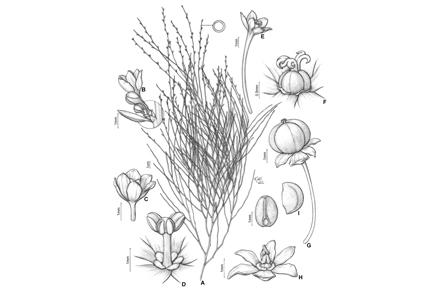Abstract
We describe Phyllanthus chapadensis, a new phyllocladiferous species of the genus Phyllanthus probable endemic to the Chapada dos Veadeiros region, Goiás, Brazil, in the Cerrado region. This region is located in Central Brazil with a high number of endemic Angiosperms, unique landscapes, and distinct and peculiar phytophysiognomies. The species described here belongs to Phyllanthus sect. Choretropsis, a Brazilian exclusive group of plants characterized by presenting phylloclades. The new species resembles P. spartioides and P. sarothamnoides, which occur in the Chapada Diamantina, Bahia, Northeastern Brazil, due to its upright shrubby habit, with thin and delicate phylloclades. However, it can be differentiated by the morphological characteristics of phylloclades and flowers. We present the main morphological distinctions between these species, distribution map, illustrations, flowering and fruiting seasons, and a proposal of the conservation status of the new species.
References
<p>Baillon, M.H. (1858) <em>Étude Génerale du Groupe des Euphorbiacée</em>. Victor Masson, Paris, 684 pp.</p>
<p>Bouman, R.W., Keβler, P.J.A., Telford, I.R.H., Bruhl, J.J. & Welzen, P.C. van. (2018) Subgeneric delimitation of the plant genus <em>Phyllanthus</em> (Phyllanthaceae). <em>Blumea</em> 63: 167‒198. https://doi.org/10.3767/blumea.2018.63.02.14</p>
<p>Bouman, R.W., Keβler, P.J.A., Telford, I.R.H., Bruhl, J.J., Strijk, J.S., Saunders, R.M.K. & Welzen, P.C. van. (2021) Molecular phylogenetics of <em>Phyllanthus</em> sensu lato (Phyllanthaceae): Towards coherent monophyletic taxa. <em>Taxon</em> 70: 72‒98. https://doi.org/10.1002/tax.12424</p>
<p>Font Quer, P. (2000) <em>Diccionario de Botánica</em>. Ediciones Península, Barcelona, 1080pp.</p>
<p>Forster, J.R. & Forster, G. (1776) <em>Characteres Generum Plantarum (second edition).</em> Prostant apud B. White, T. Cadell, & P. Elmsly, London, pp. 113‒114 & 145‒146.</p>
<p>Govaerts, R. & Radcliffe-Smith. (1996) New names and combinations in Euphorbiaceae: Phyllanthoïdeae. <em>Kew Bulletin</em> 51: 175‒178. https://doi.org/10.2307/4118755</p>
<p>IUCN (2019) <em>Guidelines for Using the IUCN Red List Categories and Criteria</em>. Version 14. Prepared by the Standards and Petitions Subcommittee. Available from: http://cmsdocs.s3.amazonaws.com/RedListGuidelines.pdf (accessed 10 March 2021)</p>
<p>Linnaeus, C. (1753) <em>Species Plantarum</em>. Laurentius Salvius, Stockholm, 1200pp.</p>
<p>Mueller, F.J.H. (1858) Fragmenta Phytogeograficae Australiae. <em>Auctoritate Gubern. Coloniae Victoriae, ex Officina Joannis Ferres, Melbourne</em> 1: 32‒33. https://doi.org/10.5962/bhl.title.116758</p>
<p>Müller Argoviensis, J. (1863) <em>Euphorbiaceae</em>. Vouläufige Mittheifungen aus dem für De Candolle’s Prodromus bestimanten Manuscript über dieses Familiae. <em>Linnaea</em> 32: 1‒786.</p>
<p>Orlandini, P., Torres, A.M., Mendes, J.C.R. & Silva, M.J. (2020a) <em>Phyllanthus</em> in Flora do Brasil 2020. Jardim Botânico do Rio de Janeiro. Available from: http://floradobrasil.jbrj.gov.br/reflora/floradobrasil/FB24160 (accessed 8 March 2021)</p>
<p>Orlandini, P., Cordeiro, I., Campos-Rocha, A. & Souza, V.C. (2020b) A new species of <em>Phyllanthus</em> L. (Phyllanthaceae) with phylloclades from Minas Gerais, Brazil. <em>Phytotaxa</em> 455: 167‒172. https://doi.org/10.11646/phytotaxa.455.2.8</p>
<p>Orlandini, P., Cordeiro, I., Mendes, J.C.R., Campos-Rocha, A. & Souza, V.C. (2021) A new species of phyllocladiferous <em>Phyllanthus</em> (Phyllanthaceae) from the Atlantic Rain Forest. <em>Systematic Botany</em> 46: 1011–1015. https://doi.org/10.1600/036364421X16370109698669</p>
<p>Pax, F. & Hoffmann, K. (1923) Euphorbiaceae americanae novae<em> In: </em>Fedde, F. (Ed.) <em>Repertorium specierum novarum regni vegetabilis </em>19 (11–13): 174–177. https://doi.org/10.1002/fedr.19230191104</p>
<p>Quantum GIS Development Team. (2017) Quantum GIS Geographic Information System. Open Source Geospatial Foudation Project. Available from: https://www.qgis.org/en/site/ (accessed 11 January 2022)</p>
<p>Radford, A.E., Dickison, W.C., Massey, J.R. & Bell, C.R. (1974) <em>Vascular Plant Systematics</em>. Harper and Row, New York, Evanston, San Francisco and London.</p>
<p>Ribeiro, J.F. & Walter, B.M.T. (1998) Fitofitofisionomias do Bioma Cerrado.<em> In: </em>Sano, S.M. & Almeida, S.P. (Eds.) <em>Cerrado: ambiente e flora.</em> Brasília: Embrapa, pp. 89–166.</p>
<p>Santiago, L.J.M. (1988) Estudos preliminares da seção <em>Choretropsis</em> Muell.Arg., gênero <em>Phyllanthus</em> (Euphorbiaceae). <em>Bradea</em> 5: 44–49.</p>
<p>Santiago, L.J.M., Louro, R.P. & Emmerich, M. (2006) <em>Phyllanthus</em> section <em>Choretropsis</em> (Euphorbiaceae) in Brazil. <em>Botanical Journal of the Linnean Society</em> 150: 131‒164. https://doi.org/10.1111/j.1095-8339.2006.00459.x</p>
<p>Thiers, B. (2021 [continuously updated]) <em>Index Herbariorum</em>: a global directory of public herbaria and associated staff. The New York Botanical Garden, New York. Available from: http://sweetgum.nybg.org/science/ih/ (accessed 10 March 2021)</p>
<p>Webster, G.L. (1956a) Studies on the Euphorbiaceae, Phyllanthoideae II. The American species of <em>Phyllanthus</em> described by Linnaeus. <em>Journal of The Arnold Arboretum</em> 37 (1): 1–14. https://doi.org/10.5962/p.185991</p>
<p>Webster, G.L. (1956b) A monographic study of the West Indian species of <em>Phyllanthus</em>. <em>Journal of The Arnold Arboretum</em> 37: 91‒122. https://doi.org/10.5962/p.324651</p>
<p>Webster, G.L. (1956c) A monographic study of the West Indian species of <em>Phyllanthus</em>. <em>Journal of The Arnold Arboretum</em> 37: 217‒256. https://doi.org/10.5962/bhl.part.25737</p>
<p>Webster, G.L. (1956d) A monographic study of the West Indian species of <em>Phyllanthus</em>. <em>Journal of The Arnold Arboretum</em> 37: 340‒357. https://doi.org/10.5962/p.324654</p>
<p>Webster, G.L. (1958) A monographic study of the West Indian species of <em>Phyllanthus</em>. <em>Journal of The Arnold Arboretum</em> 39: 111‒212. https://doi.org/10.5962/bhl.part.19111</p>
<p>Webster, G.L. (1967) The genera of Euphorbiaceae in the Southeastern United States. <em>Journal of the Arnold Arboretum </em>48: 332‒240. https://doi.org/10.5962/p.185727</p>


